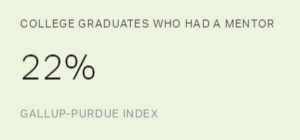Colleges and universities are supposed to be learning organizations. But, apparently, they aren't doing enough learning themselves -- at least not among their staff and faculty.
According to Gallup surveys, college and university employees rank right around the bottom-quartile on "learn and grow" measures compared with other employees in the U.S. This is a tragic irony for the very workplaces whose primary mission is, well, learning and development.
Specifically, only four out of 10 higher education staff and faculty strongly agree that in the past year they've had opportunities at work to learn and grow. And even fewer strongly agree that someone at work has discussed their progress in the last six months or that someone at work encourages their development.
Comparatively, there are many organizations outside the field of higher education where seven in 10 employees strongly agree that they have opportunities to learn and grow at work and that they have someone who encourages their development and progress.
If higher education's mission focuses on providing learning and growth for students, then we ought to care deeply and reflect seriously on the fact that staff and faculty are suffering on these dimensions.
Colleges Are Not Scoring High on Developing Students, Either
The truth is that few colleges and universities have paid careful attention to critical organizational health aspects such as the engagement, well-being and professional development of their own employees. As an industry, higher education is one of the last to recognize and embrace this type of employee development.
Some might argue that colleges and universities don't spend much time focusing on staff and faculty learning and growth because they are so invested in the learning and growth of students. But the learning and growth of staff and faculty directly correlate with the learning and growth of students. And there is, unfortunately, poor evidence of student learning and growth occurring in colleges, too.
According to the book Academically Adrift: Limited Learning on College Campuses, there is little evidence to support the assertion that higher education has made a profound impact on making students better critical thinkers, for example. And according to Gallup's surveys of college graduates, only 22% strongly agree they had a mentor who encouraged their goals and dreams and only 27% strongly agree they had a professor who cared about them personally during college.
So, higher education isn't exactly getting an A on these learning and development measures for students or graduates, either. Focusing on the learning and growth of staff and faculty will most certainly help boost student learning and growth. Further, great strides can be made by valuing and measuring this learning and growth for all the key constituents in higher education -- students and employees, especially.
Currently, though, higher education is an industry that has largely ignored measures of outcomes for students and alumni and, for that matter, staff and faculty. This is evidenced by the fact that there are virtually no student, employee, or alumni consumer-based ratings of satisfaction or quality outcomes for colleges and universities.
The one small exception to this is the annual Chronicle of Higher Education Great Colleges to Work for survey that 232 colleges and universities participated in during 2017. These 232 institutions represent less than 5% of the total 4,724 degree-granting institutions in the U.S.
In every other industry -- from restaurants and Uber rides to airlines and hospitals -- consumer-based ratings from customers, employees and patients are major components of how performance is evaluated and services are ultimately improved.
As higher education faces a number of daunting challenges heading into 2018, one of the most important investments (of time, not money!) it can make will be in that of its own staff and faculty. By placing more value and emphasis on their learning and growth, higher education will make rapid improvements in the learning and growth of its students, the communities that colleges serve, and our nation as a whole.





